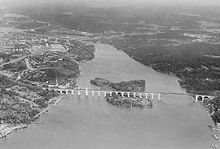Årstabroarna
Coordinates: 59 ° 18 ′ 33 ″ N , 18 ° 2 ′ 38 ″ E
Årstabroarna (the Årsta bridges ) are two parallel railway bridges over the Årstaviken in southern Stockholm , they connect the Enskede-Årsta-Vantör district with Södermalm . The older, eastern Årstabrücke dates from 1929 and is protected as a public Byggnadsminne . The newer, western Årstabrücke was inaugurated in 2005.
The eastern Årstabrücke
The eastern, older Årstabrücke was designed by the architect Cyrillus Johansson and constructed by Ernst Nilsson and Salomon Kasarnowsky, two engineers who later helped create the Tranebergsbron and the Västerbron . It took six years to build, from 1924 to 1929. Architect Johansson was inspired by ancient aqueducts and designed 19 concrete bridge arches. In the southern fairway, a steel framework spans the Årstaviken and in the northern fairway there are two tall pylons that were used to raise an entire lane segment if necessary. Two railway tracks lead over the bridge. The bridge was also prepared to carry an additional lane for road traffic, but that was never realized. The bridge was inaugurated by King Gustav V on November 23, 1929 . It is 753 meters long and 9 meters wide. The free passage height is 26 meters. The old Årstabron was extensively renovated in 2007. Work on the bridge itself was completed in November 2012, and a landing bridge was built by summer 2013 and the area around the bridge was restored.
The Årstabrücke achieved a certain fame when it was seen in the music video The Day Before You Came by the group ABBA in 1982 .
The western Årstabrücke
The western, newer Årstabrücke became necessary because the rail traffic to and from Stockholm could no longer be adequately served from the old bridge. An international architectural competition was announced by the client Banverket , which was won by the British architect Norman Foster . He had an extremely slim bridge in mind, which in no way should disturb the appearance of the old bridge, which has now become popular.
Construction work on the new bridge began in 2000. It is a prestressed reinforced concrete structure that spans Årstaviken on ten pillars. It was so slim that the engineers at the Skanska construction company struggled to accommodate the massive amounts of steel reinforcement. The double-curved shape of the underside of the bridge posed a challenge for the carpenters and iron weavers. The low overall height also did not allow a conventional track bed with sleepers and ballast, the rails were screwed directly into the concrete track without sleepers. The concrete is colored red, a shade that corresponds to traditional Falun red , which, according to Norman Foster, is a suitable color for a Swedish bridge. The foundations of the bridge piers lie at a depth of 20 to 35 meters below the surface of the water on stable rock. Two railroad tracks and two footpaths and bicycle paths lead across the bridge. The new Årstabrücke was built on August 28, 2005 by King Carl XVI. Gustaf inaugurated.
The new bridge is 833 meters long, 19.5 meters wide and offers a passage height of 26 meters.
literature
- Guide till Stockholm's architecture. Arkitektur Förlag, 2005
- Husbyggaren trade journal , No. 1, February 2005
Web links
Individual evidence
- ↑ a b project page of the tobacco shop. June 23, 2013, archived from the original on August 22, 2010 ; Retrieved October 14, 2015 (Swedish).


